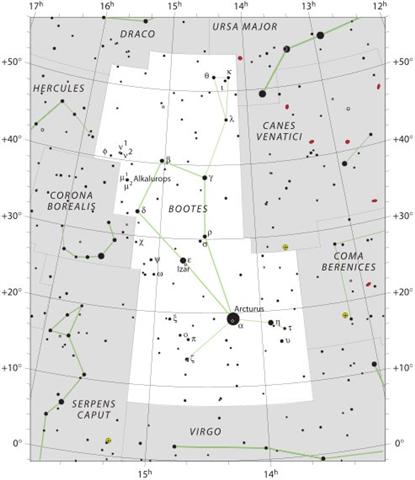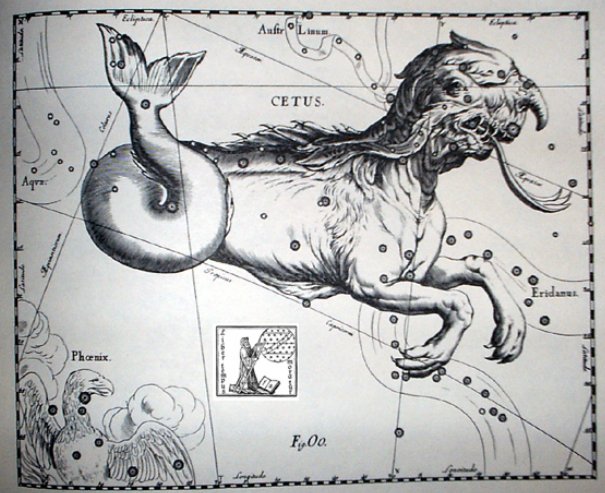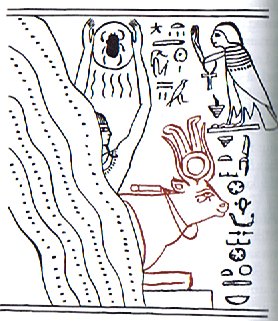My star list is
incomplete. For
instance should I
add the stars at the
hand and club of
Bootes. The last
Bootes star in my
list is Alkalurops (μ),
but the star close to
Corona Borealis (χ)
is not in my list:


|
Arcturus |
14h 15m 40.35s |
14h 15.673m |
216.4 |
|
ω |
15h 02m 06.51s |
15h 02.217m |
228.2 |
|
ψ |
15h 04m 26.86s |
15h 04.448m |
228.8 |
|
χ |
15h 14m 29.21s |
15h 14.487m |
231.3 |
|
δ |
15h 15m 30.10s |
15h 15.502m |
231.6 |
|
ν |
15h 31m 46.99s |
15h 31.783m |
235.7 |
|
φ |
15h 37m 49.55s |
15h 37.826m |
237.2 |
| |
ω Bootis |
4.80 |
25° 00′ N |
15h 00m |
228.2 |
|
Nadlat |
ψ Bootis |
4.52 |
26° 57′ N |
15h 02m |
228.8 |
| |
χ Bootis |
5.28 |
29° 10′ N |
15h 12m |
231.3 |
|
Princeps |
δ Bootis |
3.46 |
33° 19′ N |
15h 13m |
231.6 |
| |
ν Bootis |
4.98 |
40° 54′ N |
15h 29m |
235.7 |
| |
φ Bootis |
5.25 |
40° 21′ N |
15h 35m |
237.2 |
Arcturus ought to
play
a part both in the
glyph text and in
Manuscript E. Its
brilliancy (-0.05)
should make this
unavoidable.
Hevelius has drawn
it as if it marked
the anus of Bootes
and the strange word
tiaeve together
with looking either
to the right or to
the left could
indicate the choice
of way past either
ρ and σ (up toward
Haris, γ) or past
Izar (ε) toward
Princeps (δ):
...
They all formed a
line and looked
towards the waves.
When the wave began
to rise, when it
began to move faster
and faster, they all
turned the lower
part of their body
(? tiaeve)
and coasted on top
of the wave toward
the right side ...
But it is unclear
whether right and
left refers to the
picture of Hevelius
(from the outside of
the celestial globe)
or from the inside
(as we normally
can see the
constellations from
below). 'Right' in
the manuscript
possibly leads, I
think, from Arcturus to
Hanga Roa.
'Left' in the
manuscript would
then lead
from Arcturus to
Apina Iti, which
is south of Hanga
Roa. I therefore
guess 'left' means
the path past Izar
to Princeps (δ),
i.e. not according
to the view of
Hevelius but
according to the
normal star maps.
The middle path to Hanga
O Rio could then
refer to the path to
Nekkar (β).
|
Auva 2 |
3 (160) |
4 |
5 |
6 |
7 |
|
October
22 |
23 |
24 |
25 |
26 |
27 (300) |
 |
 |
 |
 |
 |
 |
|
Ca8-16 |
Ca8-17
(216) |
Ca8-18 |
Ca8-19 |
Ca8-20 |
Ca8-21 |
|
- |
Orongo
Tane |
Mauri-nui |
Mauri-kero |
Omutu |
Tireo |
|
manu
rere |
erima
marama |
|
Asellus
Tertius,
κ
Virginis
(214.8),
Arcturus
(215.4),
Asellus
Secundus
(215.5) |
Syrma,
λ Bootis
(215.6),
ι Lupi
(216.3),
Khambalia
(216.4),
υ
Virginis
(216.5) |
ψ
Centauri
(216.6) |
Asellus
Primus
(217.8),
τ Lupi
(218.1) |
φ
Virginis
(218.7),
σ Lupi
(219.1),
ρ Bootis
(219.5) |
Haris
(219.7).
σ Bootis
(220.2),
η
Centauri
(220.4) |
|
April 23 |
24 |
25 |
26 (116) |
27 |
28 |
|
Al
Muakhar
5 |
6 |
7 |
8 (345) |
9 |
10 |
|
no star
listed |
Mira
(33.7) |
no stars
listed |
Arcturus was
rising
heliacally close
to κ Virginis
(the nakshatra
star of Mira)
and in the
opening between
Asellus Tertius
and Asellus
Secundus. The
latter names
could perhaps
tell us that we
have turned
around from
moving right
(following Sun)
to moving left
(following
Moon). Asellus
Primus came 3
nights later.
Significant
seems to be the close
connections
between 109
Virginis and the
pair Izar with
ο Bootis, when
in the night
the Northern Fly
was visible
close to Moon.
October 30 - 182
= Al Muakhar 13
(350):
|
Auva 8 |
9 |
10 |
11 (168) |
|
October
28 |
29 |
30 |
31 (304) |
 |
 |
 |
 |
|
Ca8-22 |
Ca8-23 |
Ca8-24 |
Ca8-25 |
|
tagata i
te
marama |
koia
ra |
ki te
marama |
ku
hakarava |
|
ρ Lupi
(221.0),
Toliman
(221.2) |
π Bootis
(221.8),
ζ Bootis
(221.9),
Yang Mun
(222.1),
Rijl al
Awwa
(222.5) |
ο Bootis
(222.9),
Izar
(223.0),
109
Virginis
(223.3) |
Zuben
Elgenubi
(224.2),
ξ
Bootis,
ο Lupi
(224.5) |
|
April 29 |
30 |
May 1
(121) |
2 |
|
Al
Muakhar
11 |
12 |
13 (350) |
Alrescha
1 |
|
no star
listed |
Head of
the Fly
(39.6),
Kaffaljidhma
(39.8),
Angetenar
(40.2) |
Right
Wing
(40.9),
Bharani
(41.4) |
τ²
Eridani
(41.7) |
(Al Muakhar was
ruled by
Pollux. I am
using past tense
because all such
things now seem
to be totally
forgotten and no
longer having
any dominant
effects on human
affairs.)
The path from
Arcturus leading
to 'the left',
up to the right
shoulder of
Bootes according
to Hevelius, to
δ (Princeps),
makes us reach
November 7
(to be counted either
as 11 * 7 =
77 or as 9 * 7 =
63):
|
Simak 5
(175) |
11 |
Syrma 4
(187) |
11 |
Az
Zubana 3
(199) |
|
November
7 |
November
19 |
December
1 |
 |
 |
 |
|
Ca9-3
(231) |
Ca9-15
(243) |
Ca9-27
(255) |
|
koia
kua oho |
i te
mauga pu
hia |
etoru
gagata
hakaariki
kia raua |
|
Princeps
(230.6),
Zuben
Elschemali
(230.8),
μ Lupi
(231.3) |
16h
(243.5) |
Denebakrab
(254.7),
ι
Ophiuchi
(255.3),
Grafias
(255.4) |
|
ι Cor.
Borealis
(242.5),
ξ
Scorpii
(242.7),
Acrab,
Jabhat
al Akrab
(243.3),
θ Lupi,
Rutilicus
(243.5) |
|
May 9
(129) |
May 21
(141) |
June 2
(153) |
|
Alresha
8 (358) |
Sheratan
5 |
Pleione
3 (17) |
|
no star
listed |
4h
(60.9) |
no star
listed |
|
no star
listed |
This, the
'left' path
from Arcuturus,
forces us then
to go back in
time in order to reach
Nekkar (β)
at the head of
Bootes:
| 12 |
Auva 13 |
Simak 1 |
2 |
3 |
4 (174) |
| November 1 |
2 |
3 |
4 |
5 |
6 (310) |
 |
 |
 |
 |
 |
 |
| Ca8-26 (225) |
Ca8-27 |
Ca8-28 |
Ca8-29 |
Ca9-1 |
Ca9-2 (230) |
| - |
- |
- |
- |
Ohiro |
Oata |
| te ahi ki te rima aueue - te ika |
tupu te ure o te henua |
erua kiore |
Te marama erua |
| Kochab (225.0) |
Ke Kwan (226.3), Ke Kwan (226.4) |
Zuben Elakribi (226.8), Nekkar (227.3) |
15h (228.3) |
λ Lupi (228.9) |
κ Lupi (229.7), ζ Lupi (229.8), χ Bootis (230.3) |
| π Lupi (227.9), Zuben Hakrabim (228.3) |
| 3 |
May 4 |
5 (125) |
6 |
7 |
8 |
| 2 |
Alrescha 3 |
4 (354) |
5 |
6 |
7 |
| no star listed |
Acamar (43.6) |
Menkar (44.7) |
3h (45.7) |
no star listed |
Botein (46.9) |
| Algol (45.9), Misam (46.2) |
Unless
we could go directly
from Izar and
ο Bootis to
Nekkar, in which
case the
distance is
equivalent to
the path from
May 1 to May 5.
Nek-kar cannot
be avoided, it
had the
important
position when
the Auva manzil
ended and when
Men-kar (α Ceti,
the nose of the
Sea Beast) could
be seen close to
the full Moon.
227.3 - 44.7 =
182.6:

As to the star
close to the
first tine of
Corona Borealis,
χ Bootis, it
rose heliacally
in November 6
(310), in RA day
230. This
could correspond,
according to my
suggestions, to
the last night
in the C text 'Moon
calendar', viz.
Oata.
|
1 Hilo (Hiro) |
...the first night of each month and the day following it was a good one for planting. Water-melons, gourds, bananas, sugar-cane, taro, potatoes and so on, if planted on this day, would bear well. It was a day highly valued for planting. On the evening of Hilo there is a low tide until morning. On this night the women fished by hand (in the pools left by the receding sea) and the men went torch fishing. It was a calm night, no tide until morning. It was a warm night without puffs of wind; on the river-banks people caught gobey fish by hand and shrimps in hand-nets in the warm water. Thus passed the famous night of Hilo. During the day, the sea rose washing up on the sand, and returned to its old bed, and the water was rough. |
|
2 Hoaka (Hoata) |
It is a favorable day for planting, but in the old days it was a day of prayer. The hoaka, or arch over the door of a house, was named after the shape of the Moon on that night, that is, concave with the points curving up on both sides like horns ... On the evening when Hoaka rises there is low tide until morning, just like the night of Hilo. But if a man is born that night, or perhaps during the day, he will be one who grumbles about not getting his share, a trouble-maker, stingy, unmerciful, conceited. He will be clever about getting things out of others, suave, but uncourteous at heart, a person who has some lovable qualities, however, and is efficient. A woman born on that day will be one to show her teeth, although she will conceal her temper under cover of affable ways. She will be dignified and appear unassuming but be in reality a hypocrite, a vain woman, a woman always loitering about housedoors. These are the laws of birth on this day... |
Hilo was
translated as
'narrow rim' (of
light) and
Hoaka as
'clear'. In the
Oata
night Botein (δ
Arietis, the
first of the 3
stars in her
tail) could be
seen close to
the full moon.

In the
background are
the rainclouds
from which the
Bull, or in
Egypt his female
counterpart
Hathor, emerged
in spring:

The Ram is a
female creature,
because her role
is to give birth
(the important
characteristic
of spring).
The Aries
constellation means
the Ewe,
which of
course I cannot
avoid
connecting with
Polynesian
eve:
|
Eve
1.
Placenta,
afterbirth
(eeve).
T
Pau.:
eve,
womb.
Ta.:
eve,
placenta.
Ma.:
ewe,
id.
Haw.:
ewe,
navel
string.
2.
The
rear;
taki
eeve,
the
buttocks;
hakahiti
ki
te
eeve,
to
show
the
buttocks;
pupuhi
eve,
syringe.
3.
The
bottom
of
the
sea.
Churchill. |
... They all
formed a
line and
looked
towards the
waves. When
the wave
began to
rise, when
it began to
move faster
and faster,
they all
turned the
lower part
of their
body (?
tiaeve)
and coasted
on top of
the wave
toward the
right side.
Once they
were
underway
(literally,
'when the
turtle was
gone'),
their eyes
looked
toward the
land at an
angle.
Ira
called out
with a loud
voice, 'Our
ride on the
wave is to
the right!'
(Fast) as on
a sled was
the ride on
the wave,
and it
brought them
to the
shore. The
place where
they landed
was given
the name 'Hanga
Roa'."
[When they
rode the
wave from
the 3 islets
looking to
the right it
means they
must have
gone north.
Hawaiin
ewe
means navel
string and
the strange
tiaeve
could allude
to
Hanga-piko.
Piko is
Hawaiian for
Pito,
navel,
navelstring
etc.].
|












